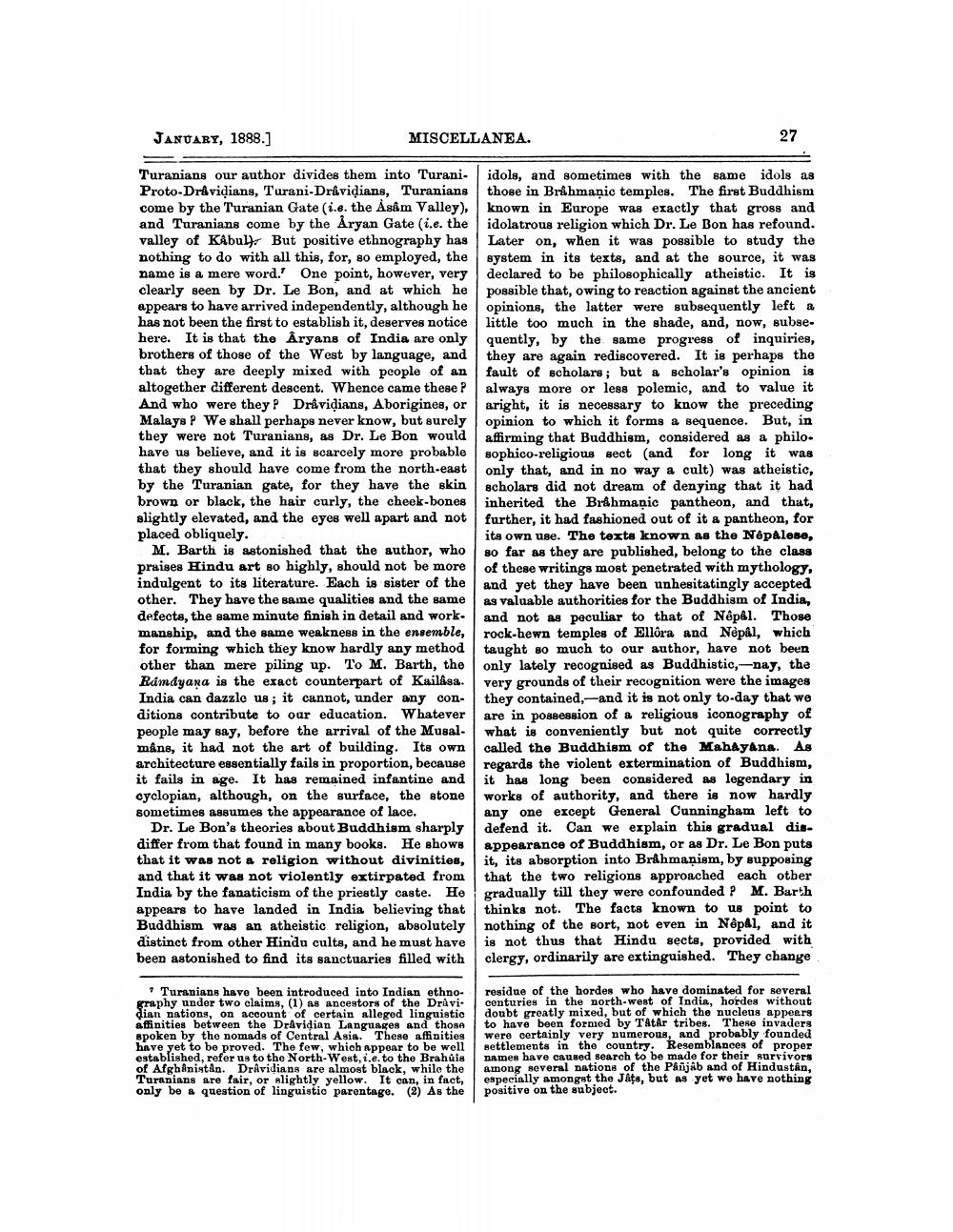________________
JANUARY, 1888.]
MISCELLANEA.
27
Turanians our author divides them into Turani- idols, and sometimes with the same idols as Proto-Drividians, Turani-Dravidians, Turanians those in Brahmaņic temples. The first Buddhism come by the Turanian Gate (i.e. the Asâm Valley), known in Europe was exactly that gross and and Turanians come by the Aryan Gate (i.e. the idolatrous religion which Dr. Le Bon has refound. valley of Kabul). But positive ethnography has Later on, when it was possible to study the nothing to do with all this, for, so employed, the system in its texts, and at the source, it was name is a mere word.' One point, however, very declared to be philosophically atheistic. It is clearly seen by Dr. Le Bon, and at which he possible that, owing to reaction against the ancient appears to have arrived independently, although he opinions, the latter were subsequently left a has not been the first to establish it, deserves notice little too much in the shade, and, now, subse. here. It is that the Aryans of India are only quently, by the same progress of inquiries, brothers of those of the West by language, and they are again rediscovered. It is perhaps the that they are deeply mixed with people of an fault of scholars; but a scholar's opinion is altogether different descent. Whence came these? always more or less polemic, and to value it And who were they? Drividians, Aborigines, or aright, it is necessary to know the preceding MalaysP We shall perhaps never know, but surely opinion to which it forms a sequence. But, in they were not Turanians, as Dr. Le Bon would affirming that Buddhism, considered as a philo. have us believe, and it is scarcely more probable sophico-religious sect (and for long it was that they should have come from the north-east only that, and in no way a cult) was atheistic, by the Turanian gate, for they have the skin scholars did not dream of denying that it had brown or black, the hair curly, the cheek-bones inherited the Brahmaņic pantheon, and that, slightly elevated, and the eyes well apart and not further, it had fashioned out of it a pantheon, for placed obliquely.
its own use. The texts known as the Nepalese, M. Barth is astonished that the author, who so far as they are published, belong to the class praises Hindu art so highly, should not be more of these writings most penetrated with mythology, indulgent to its literature. Each is sister of the and yet they have been unhesitatingly accepted other. They have the same qualities and the same as valuable authorities for the Buddhism of India, defects, the same minute finish in detail and work and not as peculiar to that of Nepal. Those manship, and the same weakness in the ensemble, rock-hewn temples of Ellora and Nepal, which for forming which they know hardly any method taught so much to our author, have not been other than mere piling up. To M. Barth, the only lately recognised as Buddhistic, -nay, the Ramdyana is the exact counterpart of Kailasa. very grounds of their recognition were the images India can dazzle us; it cannot, under any con- they contained, and it is not only to-day that we ditions contribute to our education. Whatever are in possession of a religious iconography of people may say, before the arrival of the Mugal. what is conveniently but not quite correctly mans, it had not the art of building. Its own called the Buddhism of the Mahayana. As architecture essentially fails in proportion, because regards the violent extermination of Buddhism, it fails in age. It has remained infantine and it has long been considered as legendary in cyclopian, although, on the surface, the stone works of authority, and there is now hardly sometimes assumes the appearance of lace.
any one except General Cunningham left to Dr. Le Bon's theories about Buddhism sharply defend it. Can we explain this gradual disdiffer from that found in many books. He shows appearance of Buddhism, or as Dr. Le Bon puts that it was not a religion without divinities, it, its absorption into Brahmanism, by supposing and that it was not violently extirpated from that the two religions approached each other India by the fanaticism of the priestly caste. He gradually till they were confounded P M. Barth appears to have landed in India believing that thinks not. The facts known to us point to Buddhism was an atheistic religion, absolutely nothing of the sort, not even in Nepal, and it distinct from other Hindu cults, and he must have is not thus that Hindu sects, provided with been astonished to find its sanctuaries filled with clergy, ordinarily are extinguished. They change
7 Turanians have been introduced into Indian ethnography under two claims, (1) as ancestors of the Dravidian nations, on account of certain alleged linguistic affinities between the Dråvidian Languages and those spoken by the nomads of Central Asia. These affinities have yet to be proved. The few, which appear to be well established, refer us to the North-West, i.e. to the Brahuis of Afghanistan. Dravidians are almost black, while the Turanians are fair, or slightly yellow. It can, in fact, only be a question of linguistic parentage. (2) As the
residue of the hordes who have dominated for several conturies in the north-west of India, hordes without doubt greatly mixed, but of which the nucleus appears to have been formed by Tatar tribes. These invaders were certainly very numerous, and probably founded settlements in the country. Resemblances of proper names have caused search to be made for their survivors among several nations of the Panjab and of Hindustan, especially amongst the Játs, but as yet we have nothing positive on the subject.




